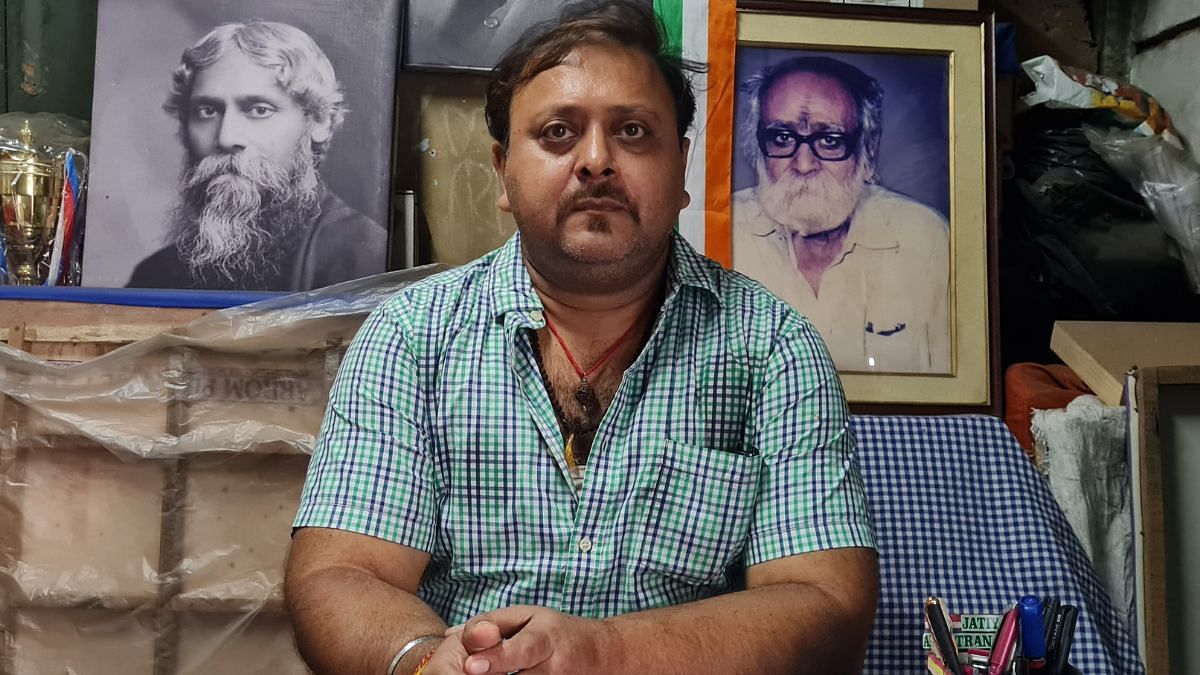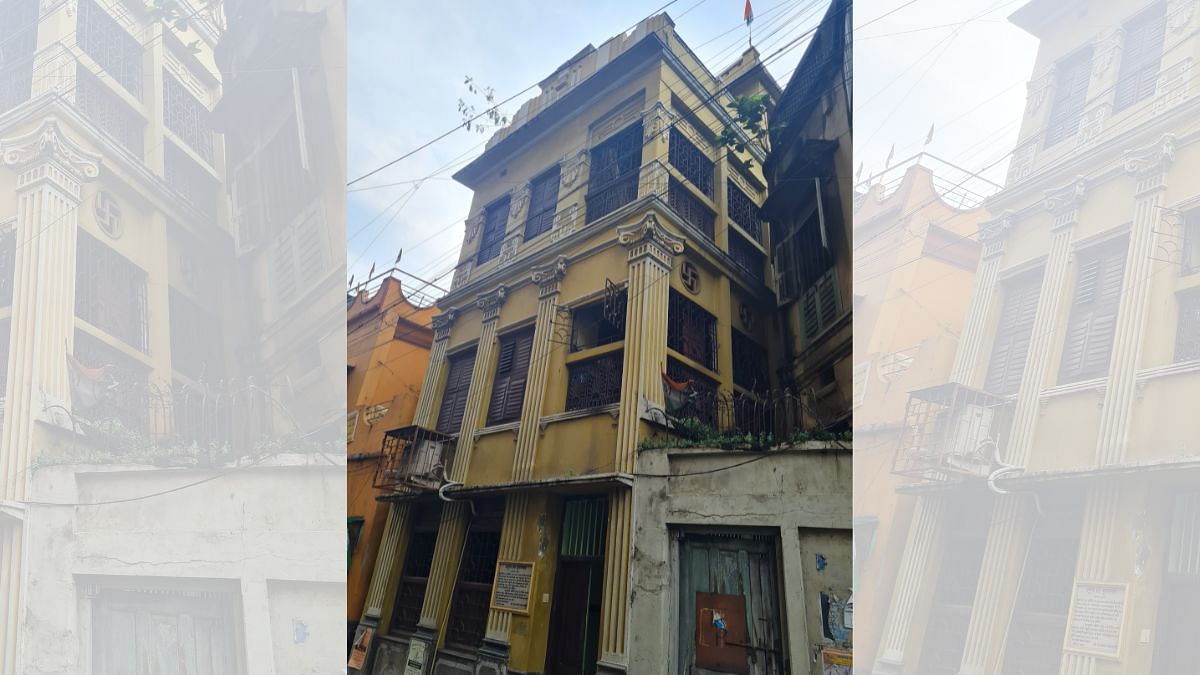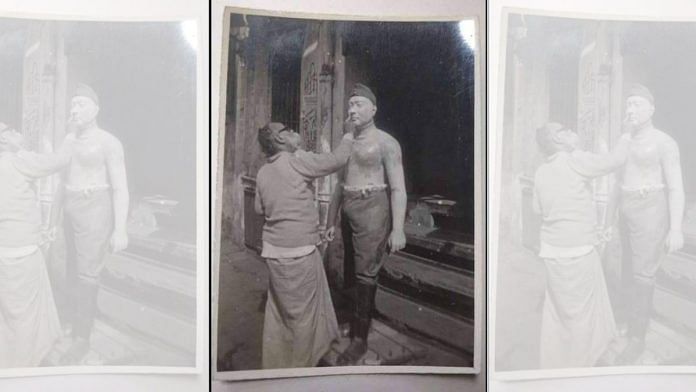Kolkata: Sitting in his office in Malanga Lane, opposite Ganesh Chandra Avenue, in Central Kolkata, Santanu Mukherjee, 44, points to the greying pictures on the wall. In most of them is a man infamously known as Gopal Patha, a key figure during the Great Calcutta Killings of August 1946, but has since then been consigned to the dustbins of history.
Gopal Patha, or Gopal Mukherjee, is Santanu Mukherjee’s grandfather and on the 77th anniversary of the Great Calcutta Killings that began on 16 August, 1946, Santanu told ThePrint that it was high time his grandfather’s name was cleared.
“My grandfather took up arms during the Great Calcutta Killings to save Hindus from marauding Muslim rioters that were killing men, raping women and burning down Hindu properties. But he bore no ill will towards Muslims,” said Santanu, a businessman and social worker.

He added that his grandfather ran a butcher shop, which the family still owns, and bought goats from Muslim sellers before, during and after the killings.
“You may not want to believe this, but Gopal Patha also saved innocent Muslims during the Great Calcutta Killings,” he said in this exclusive interview to ThePrint.
Apart from the pictures on the walls of his house — where Gopal Patha once lived — Santanu has no other trinket or memorabilia that evoke memories of his grandfather. Only stories and oral accounts shared by friends and neighbours.
There are no biopics dedicated to Gopal Patha either and talks with a team sent by a prominent filmmaker for one have failed thus far.
In 2018, a Bengali-language film called Danga the Riot, directed by Milan Bhowmik, featured a character inspired by him, but the film reportedly did not gain much traction. Moreover, media reports show that a Wikipedia page dedicated to him was also taken down earlier this year.
Also read: Nehru’s Hindu Code Bill vs Modi’s UCC— same script, same drama, different Indias
The Great Killings
Historians are divided on what happened between 16 to 21 August, 1946. “In Calcutta, although the violence was started by the [Muslim] League, the main sufferers were the Muslims of the city. Out-numbered and out-gunned, they lost more lives and had more homes burnt than their Hindu adversaries,” wrote historian Ramachandra Guha in a 2014 article for The Telegraph titled ‘Divided or Destroyed — Remembering Direct Action Day’.
But this much is uncontested that the events of 16 August, 1946, unfolded soon after a Muslim League Council Meeting on 27-29 July, 1946, passed a resolution that 16 August, 1946, would be ‘Direct Action Day’, aimed at taking direct action for a Muslim-majority Pakistan.
Research scholar Monidipa Bose Dey, in an article for Firstpost last year wrote: “Jinnah was clear enough in his indications of his intentions when he boldly stated he will have ‘India divided or India burned’, and the Muslim League had said ‘goodbye to Constitutional methods’ and was ready to ‘create trouble’.”
She added that this was supported by Husseyn Shahid Suhrawardy, the then Bengal chief minister, who said “no actions were to be taken against the armed Muslims should they decide to unleash their activities in the city (Yasmin Khan, ibid, p 65).”
“Jinnah specifically used the religious and communal symbols and idioms to charge up the Muslim community into starting violence for a forced carving out of a separate nation as a Muslim homeland,” she wrote.
According to Santanu, it was during this mayhem that his grandfather decided to “form an army to save Hindus”.
“He formed the Bharater Jatiya Bahini with Bengali, Odia, Bihari and Punjabi Hindus from the neighbourhood to take on the Muslim gangs that were unleashed by Suhrawardy,” said Santanu.

Santanu said that the statement attributed to his grandfather — “if they kill one Hindu, I will kill 10 Muslims” — was indeed spoken by him.
“He said this. But he also laid down rules of engagement. Many do not know but my grandfather did not just own a butcher shop, he was part of the Anusilan Samiti, fitness clubs that supported secret societies of armed revolutionaries against British rule in India. And the Samiti made him a man of strong moral character. He told his men that they won’t attack innocent Muslims, nor would they touch their women, children and elderly. Only those who came to attack with arms would be dealt with,” said Santanu.
Monidipa Bose Dey, too, wrote this in her article: “As the Hindu resistance gained ground, the numbers of Muslim casualties rose, and soon the latter panicked and started leaving the city, even though the clashes continued for nearly a week. From 18th to 20th August, Gopal Patha and the other Hindu leaders specifically identified and killed the Muslims who had taken part in rapes and killings of the Hindus. Members of the Muslim National Guard, a militant body associated with the Muslim League, were killed in large numbers; however no Muslim women or children were touched by the Hindus during the resistance.”
Santanu rued the fact that his grandfather’s name, if mentioned at all, is spoken with derision.
“Let me tell you a story. When the Great Calcutta Killings were happening, Muslims of this locality came to my grandfather and asked him if they should leave. My grandfather told them they have done no wrong and he would protect them with his life. It is Muslim rioters he is fighting against. Will you call such a man communal?” Santanu asked.
Also read: ‘Air India ki flight mat lo’ — how Canadian neglect led up to Kanishka bombing 38 yrs ago
No love lost for Gandhi
Another story about his grandfather is that he defied Mahatma Gandhi. “Yes, he did. Later in the year when Gandhi came to Kolkata to spread the message of non-violence, he met my grandfather and asked him to lay down his arms,” said Santanu.
“My grandfather told Gandhi he won’t even lay down a nail if it is used to protect Hindus,” he said.
“Gopal Mukherjee believed that if you are attacked, you have to pick up arms to defend yourself. Gandhi’s sermons on non-violence won’t save you during riots,” he added.
A Gopal Patha biopic?
According to Santanu, a famous Bollywood director recently sent his team to speak to him about a biopic based on his grandfather but things haven’t worked out. “I did not like the way they were thinking about the film. I do not want my grandfather’s story to be politicised. History is nuanced. One should not twist it for narrow ends,” he said.
Will he never agree to a Gopal Patha biopic? “I will if I agree with the portrayal. I do not want to tarnish my family’s name any more,” he said.
Speaking to ThePrint, National-Award winning filmmaker Subhrajit Mitra said: “A Gopal Patha biopic is an interesting idea, but one should research him before attempting a film on him. We have this tendency of making heroes and villains of historical figures. That is propaganda. But this much can be said of Gopal Patha — he did indeed save a lot of Hindus during the Great Calcutta Killings. The rest is up for debate.”
(Edited by Zinnia Ray Chaudhuri)
Also read: Gandhi spoke no Sanskrit & Narayana Guru spoke no English when they met during Vaikom



